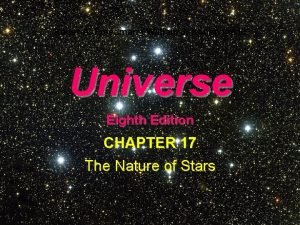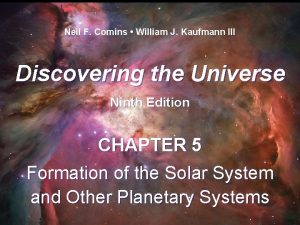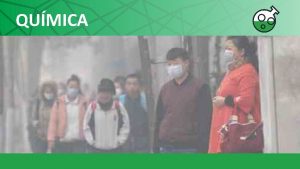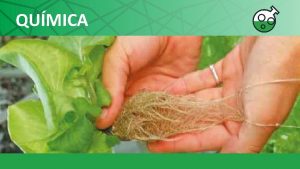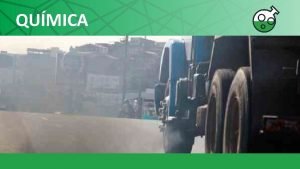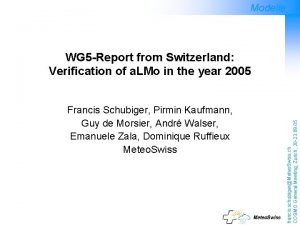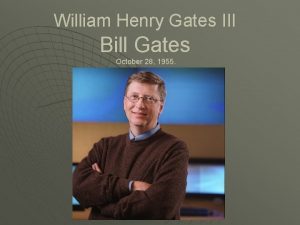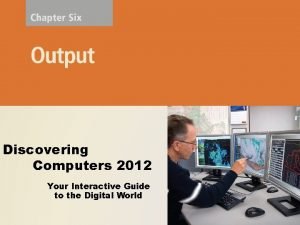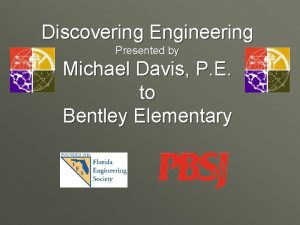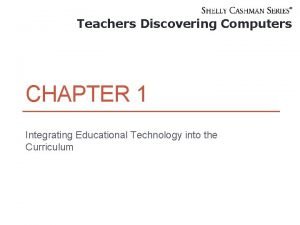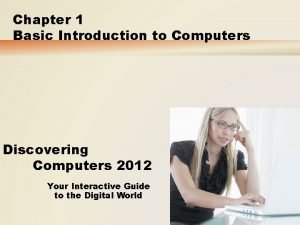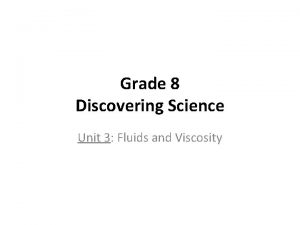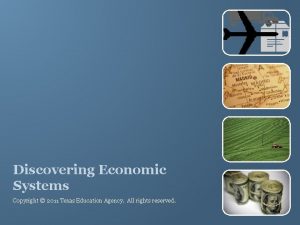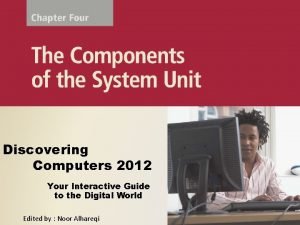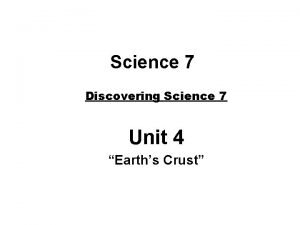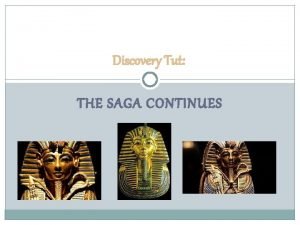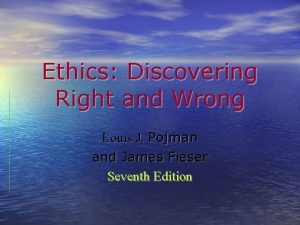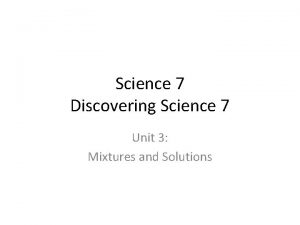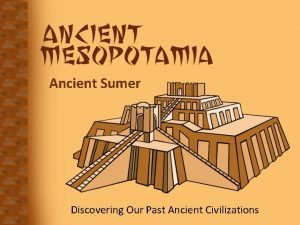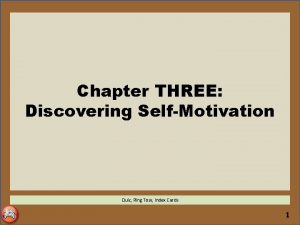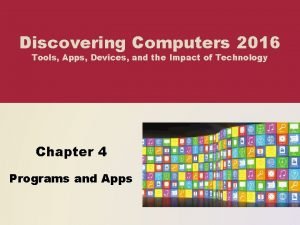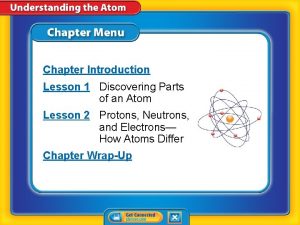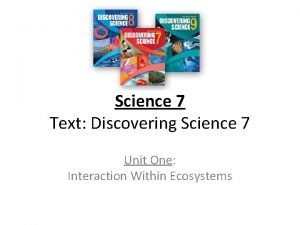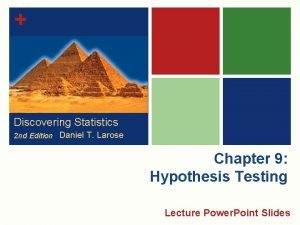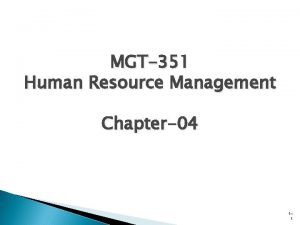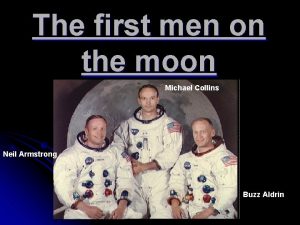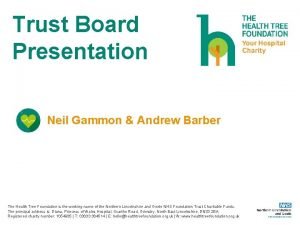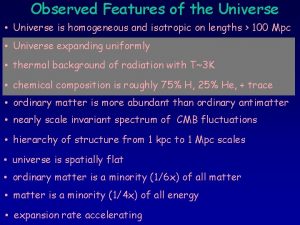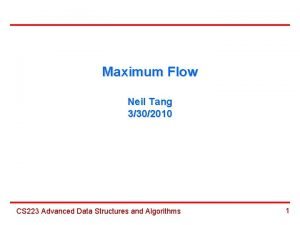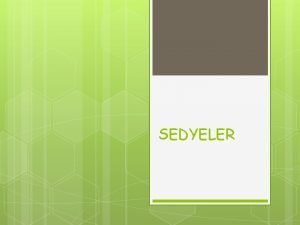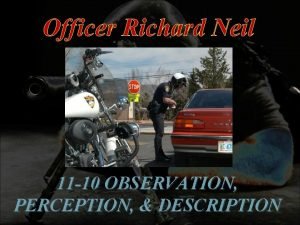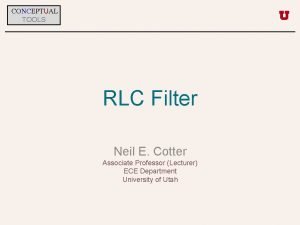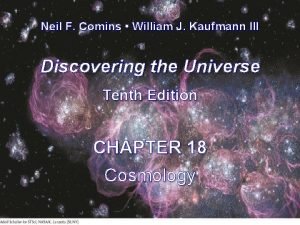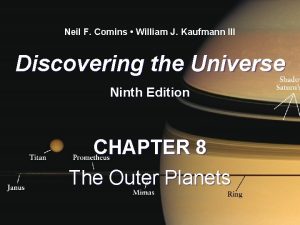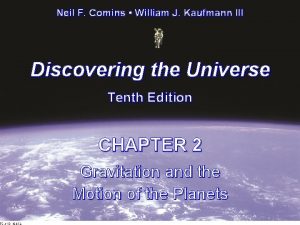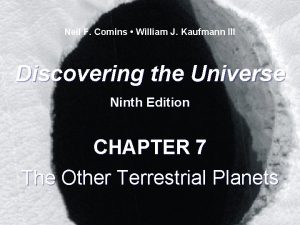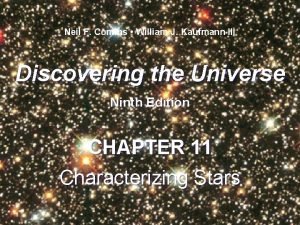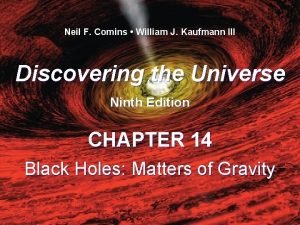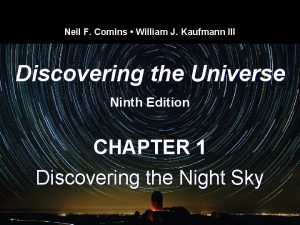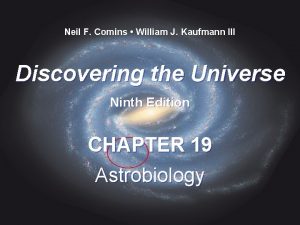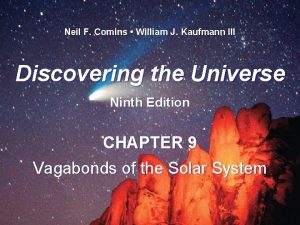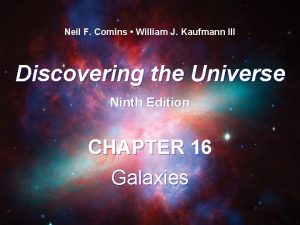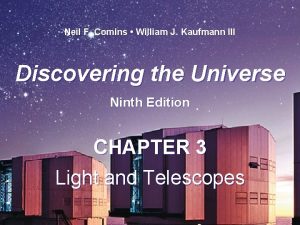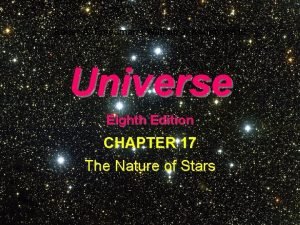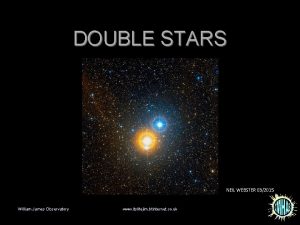Neil F Comins William J Kaufmann III Discovering



























































- Slides: 59

Neil F. Comins • William J. Kaufmann III Discovering the Universe Ninth Edition CHAPTER 6 Earth and the Moon

WHAT DO YOU THINK? 1. 2. 3. 4. 5. 6. Can Earth’s ozone layer, which has been partially depleted, be naturally replenished? Who was the first person to walk on the Moon, and when did this event occur? Do we see all parts of the Moon’s surface at some time throughout the lunar cycle? Does the Moon rotate and, if so, how fast? What causes the ocean tides? When does the spring tide occur?

In this chapter you will discover… l l l l why Earth is such an ideal environment for life that Earth is constantly in motion inside and out how Earth’s magnetic field helps protect us what made the craters on the Moon how the Sun and the Moon cause Earth’s tides that Earth and the Moon each have two (different) major types of surface features that water ice has been found on the Moon

Views of Earth’s Surface An oasis in the forbidding void of space, Earth is a world of unsurpassed beauty and variety. Ever-changing cloud patterns drift through its skies. More than two-thirds of its surface is covered with oceans. This liquid water, in combination with a huge variety of chemicals from its lands, led to the formation and evolution of life over most of the planet’s surface. The symbol is astronomers’ shorthand for “Earth. ”


Temperature Profile of Earth’s Atmosphere The atmospheric temperature changes with altitude because of the way sunlight and heat from Earth’s surface interact with various gases at different heights.

The Greenhouse Effect in a Car The glass windows in this car allow visible light to enter but prevent the infrared radiation released by the car’s interior from escaping. The infrared, therefore, heats the air in the car much higher than the outside air. This action also occurs in greenhouses and is called the greenhouse effect.

The Greenhouse Effect Sunlight and heat from Earth’s interior warm Earth’s surface, which in turn radiates energy, mostly as infrared radiation. Much of this radiation is absorbed by atmospheric carbon dioxide and water, increasing Earth’s temperature. In equilibrium, Earth radiates as much energy as it receives.

The Greenhouse Effect The amount of carbon dioxide in our atmosphere since 1000 A. D. has been determined. The increase in carbon dioxide since 1800 due to burning fossil fuels and decreases in forestation have caused a dramatic temperature increase.

The surface of Earth, or the crust, is made of less-dense rock floating on a layer of denser material. Shown here is an artist’s rendition of one such boundary, a mountain range in the middle of the ocean floor, called the Mid. Atlantic Ridge.

The Supercontinent Pangaea The present continents are pieces of what was once a bigger, united body called Pangaea.

The Supercontinent Pangaea Geologists believe that Pangaea must have first split into two smaller supercontinents, which they call Laurasia and Gondwana.

The Supercontinent Pangaea These bodies later separated into the continents of today. Gondwana split into Africa, South America, Australia, and Antarctica, while Laurasia divided to become North America and Eurasia.

Earth’s Major Tectonic Plates continue to shape Earth

Differentiation as Earth Formed Early Earth was initially a homogeneous mixture of elements. (a) Molten iron sank to the center and light material floated upward to form a crust. (b) As a result, Earth has a dense iron core and a crust of light rock, with a mantle of intermediate density between them.

Convection is a familiar process Heat supplied by the heating coil warms the water at the bottom of the pot. The heated water rises and transfers its heat to the cooler surroundings. When the hot, rising water gets to the top of the pot, it loses heat and sinks back to the bottom of the pot to repeat the process.

Convection and the Mechanism of Plate Tectonics Convection currents in Earth’s interior are responsible for pushing around rigid plates on its crust. New crust forms in oceanic rifts, where magma oozes upward between separating plates. Mountain ranges and deep oceanic trenches are formed where plates collide and crust sometimes sinks back into the interior.

Earth’s Magnetic Field Although Earth does not contain a bar magnet, its rotation, combined with moving electric charges in its core, creates a field similar to the bar magnet’s. Note that the field is not aligned with Earth’s rotation axis.

Earth’s Magnetosphere Earth’s magnetic field carves out a cavity in space that excludes charged particles ejected from the Sun, called the solar wind. Most of the particles of the solar wind are deflected around Earth in the blue region. Some charged particles in two huge, doughnut-shaped rings called the Van Allen belts (in red).

The Northern Lights (Aurora Borealis) Charged particles from the Sun can overload the Van Allen belts and cascade toward Earth, producing auroras that can be seen over a wide range of latitudes. Auroras typically occur 100 to 400 km above Earth’s surface.

Northern Lights (Aurora Borealis) – side view This is a view of an aurora from space. Part of a space shuttle is visible at the bottom left of the picture.

The Northern Lights (Aurora Borealis) This is the Aurora borealis in Alaska. The gorgeous aurora seen here is mostly glowing green due to emission by oxygen atoms in our atmosphere. Some auroras remain stationary for hours, while others shimmer, like curtains blowing in the wind.


Earth’s Magnetic Field Earth’s Magnetic field is closely related to all of the following EXCEPT: A) Compass needles point north B) Earth is shielded from the solar wind C) Radiation is trapped in the Van Allen belts D) Hurricanes rotate counterclockwise E) The Aurora Borealis (Northern Lights)


A Microscopic Lunar Crater This photograph, made with a microscope, shows tiny microcraters less than 1 mm across on a piece of Moon rock.

Mare Imbrium and the Surrounding Highlands Mare Imbrium, the largest of the 14 dark plains that dominate the Earth-facing side of the Moon, is ringed by lighter-colored highlands strewn with craters and towering mountains. The highlands were created by asteroid impacts pushing land together.

Details of a Lunar Mare Close-up views of the lunar maria reveal rilles and numerous small craters

Astronaut David Scott on Hadley’s rille during the Apollo 15 mission to the Moon.

The Far Side of the Moon Using a laser mounted on the Lunar Reconnaissance Orbiter, this detailed image of the lunar far side was made in 2010. Going by the colors of the rainbow, violet indicates lowest terrain, while red indicates highest.

An Apollo Astronaut on the Moon Apollo 17 astronaut Harrison Schmitt enters the Taurus -Littow Valley on the Moon. The enormous boulder seen here slid down a mountain to the right of this image, fracturing on the way.

The Moon’s surface is covered with a layer of powdered rock and small pieces of rock. The powdered rock is called regolith.

Mare Basalt

Anorthosite

Impact Breccias These rocks are created from shattered debris fused together under high temperature and pressure. Such conditions prevail immediately following impacts of space debris on the Moon’s surface.

Apollo 11 Landing Site On the Moon’s Sea of Tranquility, Astronaut Buzz Aldrin stands next to the package of equipment containing the seismic detector. The corner reflectors are still used today to determine the distance from Earth to the Moon.

As the Moon’s interior shrank, the surface settled irregularly, creating long lines of cliffs called scarps.

Seismic experiments revealed that the main regions of the Moon’s interior mimic those of Earth, but in different proportions. Water ice may exist in the polar craters, where the energy received from the Sun is insufficient to melt it.

This computer simulation shows how the Moon could have been formed in a collision between Earth and a large planetesimal.

The collision that created the Moon could have also knocked Earth’s rotation axis over so that today it has a 23½° tilt, thereby creating the seasons.

Motion of Earth-Moon System Barycenter (a) The paths of Earth and the Moon as their barycenter follows an elliptical orbit around the Sun.

Synchronous Rotation of the Moon For the Moon to keep the same side facing Earth as it orbits our planet, the Moon must rotate on its axis at precisely the same rate that it revolves around Earth.

Tidal Forces – Differ over an Object and Cause Tides

During new and full moon phases, the Sun’s gravitation boosts the tidal bulges in the During the quarter moon same direction as the phases, the Sun pulls the tidal Moon, creating larger bulges in a different direction “spring tides”. from the Moon, diminishing the tides. These are “neap tides. “


Lunar Ranging Beams of laser light are fired through three telescopes. The light is then reflected back by the corner reflectors on the Moon. From the time it takes the light to reach the Moon and return to Earth, astronomers can determine the distance to the Moon to within a few millimeters.

Tides The strongest tides (highs and lows) occur when: A) Full Moon B) New Moon C) Both Full and New Moon D) At First and Third Quarter Moon

Summary of Key Ideas

Earth: A Dynamic, Vital World l l l Earth’s atmosphere is about four-fifths nitrogen and one-fifth oxygen. This abundance of oxygen is due to the biological processes of life-forms on the planet. Earth’s atmosphere is divided into layers named the troposphere, stratosphere, mesosphere, and ionosphere. Ozone molecules in the stratosphere absorb ultraviolet light rays. The outermost layer, or crust, of Earth offers clues to the history of our planet. Earth’s surface is divided into huge plates that move over the upper mantle. Movement of these plates, a process called plate tectonics, is caused by convection in the mantle. Also, upwelling of molten material along cracks in the ocean floor produces seafloor spreading. Plate tectonics is responsible for most of the major features of Earth’s surface, including mountain ranges, volcanoes, and the shapes of the continents and oceans.

Earth: A Dynamic, Vital World l l l Study of seismic waves (vibrations produced by earthquakes) shows that Earth has a small, solid inner core surrounded by a liquid outer core. The outer core is surrounded by the dense mantle, which in turn is surrounded by the thin, low-density crust. Earth’s inner and outer cores are composed primarily of iron. The mantle is composed of iron-rich minerals. Earth’s magnetic field produces a magnetosphere that surrounds the planet and deflects the solar wind. Some charged particles from the solar wind are trapped in two huge, doughnut-shaped rings called the Van Allen belts. An Earthward deluge of particles from a coronal mass ejection on the Sun can produce exceptional auroras.

The Moon and Tides l l The Moon has heavily cratered highlands and relatively smooth-surfaced maria. Powdered into regolith, the anorthosite rock of the highland is brighter than the powdered basalt of the maria. Many lunar rock samples are solidified lava formed largely of minerals also found in Earth rocks. Anorthositic rock in the lunar highlands was formed between 4. 0 and 4. 3 billion years ago, whereas the mare basalts solidified between 3. 1 and 3. 8 billion years ago. The Moon’s surface has undergone very little geologic change over the past 3 billion years. Impacts have been the only significant “weathering” agent on the Moon; the Moon’s regolith (pulverized rock layer) was formed by meteoritic action. Lunar rocks brought back to Earth contain no water and are depleted of volatile elements.

The Moon and Tides l l Frozen water has been discovered in numerous places just below the Moon’s surface. The collision-ejection theory of the Moon’s origin, accepted by most astronomers, holds that the young Earth was struck by a huge planetesimal, and debris from this collision coalesced to form the Moon. The Moon was molten in its early stages, and the anorthositic crust solidified from low-density magma that floated to the lunar surface. The mare basins were created later by the impact of planetesimals and were then filled with lava from the lunar interior. Gravitational interactions between Earth and the Moon produce tides in the oceans of Earth and set the Moon into synchronous rotation. The Moon is moving away from Earth, and consequently, Earth’s rotation rate is decreasing.

Key Terms anorthosite capture theory cocreation theory collision-ejection theory continental drift convection core coronal mass ejection crust dynamo theory ejecta blanket fission theory highlands impact breccias ionosphere (thermosphere) mantle mare (plural maria) mare basalt mascons mesosphere neap tide northern lights (aurora borealis) ozone layer planetary differentiation plate tectonics regolith rille scarps seafloor spreading seismic waves seismograph solar wind southern lights (aurora australis) spring tide stratosphere synchronous rotation troposphere Van Allen radiation belts

WHAT DID YOU THINK? l l Can Earth’s ozone layer, which has been partially depleted, be naturally replenished? Yes. Ozone is created continuously from normal oxygen molecules by their interaction with the Sun’s ultraviolet radiation.

WHAT DID YOU THINK? l l Who was the first person to walk on the Moon, and when did this event occur? Neil Armstrong was the first person to set foot on the Moon. He and Buzz Aldrin flew on the Apollo 11 spacecraft piloted by Michael Collins. Armstrong and Aldrin set down the Eagle Lander on the Moon on July 20, 1969.

WHAT DID YOU THINK? l l Do we see all parts of the Moon’s surface at some time throughout the lunar cycle? No. Because the Moon’s rotation around Earth is synchronous, we always see the same side. The far side of the Moon has been seen only from spacecraft that pass or orbit it.

WHAT DID YOU THINK? l l Does the Moon rotate and, if so, how fast? The Moon rotates at the same rate that it revolves around Earth, once every 27. 3 days. If the Moon did not rotate, then, as it revolved, we would see its entire surface from Earth, which we do not.

WHAT DID YOU THINK? l l What causes the ocean tides? The tides are created by gravitational forces from the Moon and Sun combined with Earth’s motion around the barycenter.

WHAT DID YOU THINK? l l When does the spring tide occur? Spring tides occur during each full and new Moon.
 Neil comins
Neil comins Neil comins
Neil comins Hamlet act iii scene iii
Hamlet act iii scene iii The kaufman diet
The kaufman diet Cathy kaufmann
Cathy kaufmann Ahk london
Ahk london Philippe spitaleri kaufmann
Philippe spitaleri kaufmann Büroausstattung englisch
Büroausstattung englisch Camp emma kaufmann
Camp emma kaufmann Eric kaufmann birkbeck
Eric kaufmann birkbeck Crioscopia
Crioscopia Kaufmann
Kaufmann Optimieren von nutzungsprozessen im e-commerce
Optimieren von nutzungsprozessen im e-commerce Philippe spitaleri kaufmann
Philippe spitaleri kaufmann Pirmin kaufmann
Pirmin kaufmann William henry gates iii was born on 28 october 1955
William henry gates iii was born on 28 october 1955 Tactile output device
Tactile output device Discovering engineering
Discovering engineering Discovering computers 2018 chapter 1
Discovering computers 2018 chapter 1 Discovering computers 2018 chapter 1
Discovering computers 2018 chapter 1 Discovering the internet
Discovering the internet Density particles
Density particles Discovering economic systems guided practice
Discovering economic systems guided practice Benjamin latrobe
Benjamin latrobe Discovering computers 2012
Discovering computers 2012 Discovering american ideals in primary sources
Discovering american ideals in primary sources Discovering science 7
Discovering science 7 Self motivation definition
Self motivation definition Discovering cells
Discovering cells A r williams author of discovering tut
A r williams author of discovering tut Discovering computers 2011
Discovering computers 2011 Discovering computers 2018 ppt download
Discovering computers 2018 ppt download Ethics discovering right and wrong
Ethics discovering right and wrong Teachers discovering computers
Teachers discovering computers Muhammad computer technology
Muhammad computer technology Pure substances
Pure substances Discovering our past ancient civilizations
Discovering our past ancient civilizations Discovering personal genius
Discovering personal genius Discovering self motivation
Discovering self motivation Discovering computers 2016
Discovering computers 2016 Chapter 7 lesson 1 discovering parts of an atom answer key
Chapter 7 lesson 1 discovering parts of an atom answer key Pioneer species
Pioneer species P value
P value Job description and job specification in hrm
Job description and job specification in hrm Neil tang
Neil tang Michael collins buzz aldrin and neil armstrong
Michael collins buzz aldrin and neil armstrong Twilight zone beauty
Twilight zone beauty Dr neil munro
Dr neil munro Neil gammen
Neil gammen Neil dempster
Neil dempster Neil postman
Neil postman Neil turok
Neil turok Pendulous tuberosity
Pendulous tuberosity Dr neil jackson
Dr neil jackson Cs
Cs Sedye genişliği
Sedye genişliği Richard neil watch
Richard neil watch Neil cotter
Neil cotter Race racism and sports journalism
Race racism and sports journalism Neil vickers
Neil vickers
